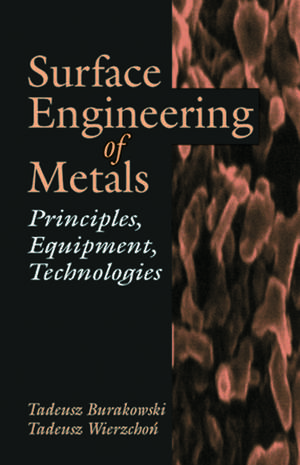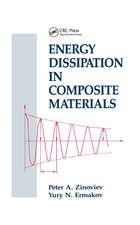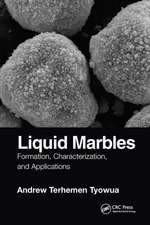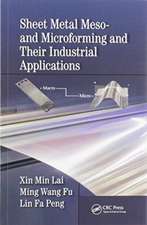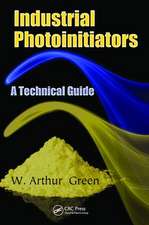Surface Engineering of Metals: Principles, Equipment, Technologies: Materials Science & Technology
Autor Tadeusz Burakowski, Tadeusz Wierzchonen Limba Engleză Hardback – 23 dec 1998
Part I outlines the fundamentals of surface engineering, presents the history of its development, and proposes a two-category classification of surface layers. Discussions include the basic potential and usable properties of superficial layers and coatings, explaining their concept, interaction with other properties, and the significance of these properties for proper selection and functioning.
Part II provides an original classification of the production methods of surface layers. Discussions include the latest technologies in this field, characterized by directional or beam interaction of particles or of the heating medium with the treat surface.
| Toate formatele și edițiile | Preț | Express |
|---|---|---|
| Paperback (1) | 475.14 lei 6-8 săpt. | |
| CRC Press – 30 sep 2020 | 475.14 lei 6-8 săpt. | |
| Hardback (1) | 1671.13 lei 6-8 săpt. | |
| CRC Press – 23 dec 1998 | 1671.13 lei 6-8 săpt. |
Preț: 1671.13 lei
Preț vechi: 2037.97 lei
-18% Nou
Puncte Express: 2507
Preț estimativ în valută:
319.76€ • 333.86$ • 264.65£
319.76€ • 333.86$ • 264.65£
Carte tipărită la comandă
Livrare economică 05-19 aprilie
Preluare comenzi: 021 569.72.76
Specificații
ISBN-13: 9780849382253
ISBN-10: 0849382254
Pagini: 608
Ilustrații: 84 Tables, black and white
Dimensiuni: 156 x 234 x 34 mm
Greutate: 0.95 kg
Ediția:UK edition
Editura: CRC Press
Colecția CRC Press
Seria Materials Science & Technology
ISBN-10: 0849382254
Pagini: 608
Ilustrații: 84 Tables, black and white
Dimensiuni: 156 x 234 x 34 mm
Greutate: 0.95 kg
Ediția:UK edition
Editura: CRC Press
Colecția CRC Press
Seria Materials Science & Technology
Public țintă
ProfessionalCuprins
Part i. General Fundamentals of Surface Engineering -- 1. The concept of surface engineering -- 1.1 The term "surface engineering" -- 1.2 Scope of topics forming the concept of surface engineering -- References -- 2. Development of surface engineering -- 2.1 History of development of surface engineering -- 2.1.1 General laws of development -- 2.1.2 History of development of metallic structural materials -- 2.1.3 History of development of the technology of -- surface improvement of structural materials -- 2.2 Surface engineering today -- 2.2.1 General areas of activity of surface engineering -- 2.2.2 Significance of surface engineering -- 2.3 Directions of development of surface engineering -- 2.3.1 Perfection and combination of methods of manufacturing of surface layers -- 2.3.2 Design of surface layers, based on mathematical modeling -- 2.3.3 Micro and nanometric testing -- 2.3.4 Rational application of surface layers -- References -- 3. The solid surface -- 3.1 The significance of the surface -- 3.2 The surface - geometrical concept -- 3.3 The surface - mechanical concept -- 3.4 The surface - physico-chemical concept -- 3.4.1 The phase -- 3.4.2 Interphase surface - a physical surface -- 3.4.3 Surface energy -- 3.4.4 Surface phenomena -- References -- 4. Surface layers -- References -- 5. The superficial layer -- 5.1 Development of concepts regarding the superficial layer -- 5.2 Shaping of the superficial layer -- 5.3 Structure of the superficial layer -- 5.3.1 Simplified models of the superficial layer -- 5.3.2 The developed model of the superficial layer -- 5.4 A general characteristic of the superficial layer -- obtained by machining -- 5.5 Physical description of the superficial layer -- 5.6 Strengthening and weakening of the superficial layer -- 5.7 Potential properties of the superficial layer -- 5.7.1 Geometrical parameters of the superficial layer -- 5.7.1.1 Three-dimensional structure of the surface -- 5.7.1.2 Surface roughness -- 5.7.1.3 Structural flaws of the three-dimensional surface -- 5.7.2 Stereometric-physico-chemical parameters of the superficial layer -- 5.7.2.1 Emissivity -- 5.7.2.2 Reflectivity -- 5.7.3 Physico-chemical parameters of the superficial layer -- 5.7.3.1 General characteristic -- 5.7.3.2 Metallographic structure -- 5.7.3.3 Hardness -- 5.7.3.4 Brittleness -- 5.7.3.5 Residual stresses -- 5.7.3.6 Absorption -- 5.7.3.7 Adsorption -- 5.7.3.8 Solubility -- 5.7.3.9 Diffusion -- 5.7.3.10 Adhesion -- 5.7.3.11 Catalysis -- 5.8 Practically usable properties of the superficial layer -- 5.8.1 Strength properties -- 5.8.1.1 General characteristic -- 5.8.1.2 Fatigue strength -- 5.8.2 Tribological properties -- 5.8.2.1 Types of basic tribological properties -- 5.8.2.2 Types of friction -- 5.8.2.3 Sliding friction -- 5.8.2.4 Rolling friction -- 5.8.2.5 The role of surface in the friction process -- 5.8.2.6 Thermal effects of friction -- 5.8.2.7 Lubrication -- 5.8.2.8 Tribological wear and its various versions -- 5.8.2.9 Factors affecting tribological wear -- 5.8.2.10 Non-wear friction (selective carryover) -- 5.8.2.11 Limiting tribological wear -- 5.8.3 Anti-corrosion properties -- 5.8.4 Decorative properties -- 5.9 The significance of the superficial layer -- References -- 6. Coatings -- 6.1 The concept of the coatings -- 6.2 Structure of the coating -- 6.3 Types of coatings -- 6.3.1 Division of coatings by material -- 6.3.1.1 Metallic coatings -- 6.3.1.2 Non-metallic coatings -- 6.3.2 Classification of coatings by application -- 6.3.2.1 Protective coatings -- 6.3.2.2 Decorative coatings -- 6.3.2.3 Protective-decorative coatings -- 6.3.2.4 Technical coatings -- 6.3.3 Classification of coatings by manufacturing methods -- 6.3.3.1 Galvanizing -- 6.33.2 Immersion coatings -- 6.3.3.3 Spray coatings -- 6.3.3.4 Cladded coatings -- 6.3.3.5 Crystallizing coatings -- 6.4 Potential properties of coatings -- 6.4.1 Geometrical parameters of coatings -- 6.4.1.1 Thickness -- 6.4.1.2 Three-dimensional structure of the surface -- 6.4.1.3 Surface unevenness -- 6.4.1.4 Defects of the three-dimensional structure -- 6.4.2 Geometric and physico-chemical parameters of coatings -- 6.4.3 Physico-chemical parameters of coatings -- 6.4.3.1 General characteristic -- 6.4.3.2 Structure of metallic coatings -- 6.4.3.3 Residual stresses -- 6.4.3.4 Adhesion -- 6.4.3.5 Hardness -- 6.4.3.6 Ductility (elasticity) -- 6.4.3.7 Electrical properties -- 6.4.3.8 Magnetic properties -- 6.5 Service properties of coatings -- 6.5.1 Anti-corrosion properties -- 6.5.1.1 Types of corrosion -- 6.5.1.2 Corrosion resistance -- 6.5.1.3 Porosity -- 6.5.1.4 Bulging -- 6.5.1.5 Permeability -- 6.5.2 Decorative properties -- 6.5.2.1 External appearance -- 6.5.2.2 Color -- 6.5.2.3 Luster -- 6.5.2.4 Coverability -- 6.5.2.5 Specific decorative properties -- 6.6 Significance and directions of development of coatings -- References -- Part ii. The newest techniques of producing surface layers -- 1. Formation of technological surface layers -- 1.1 Techniques of formation of technological surface layers -- 1.1.1 Mechanical techniques -- 1.1.2 Thermo-mechanical techniques -- 1.1.3 Thermal techniques -- 1.1.4 Thermo-chemical techniques -- 1.1.5 Electrochemical and chemical techniques -- 1.1.6 Physical techniques -- 1.2 Classification of techniques of producing technological surface layers -- References -- 2. Electron beam technology -- 2.1 Advent and development of electron beam technology -- 2.2 Physical principles underlying the functioning -- of electron beam equipment -- 2.2.1 Electron emission -- 2.2.2 Thermoelectron emission -- 2.2.3 Utilization of plasma as a source of electrons -- 2.2.4 Acceleration of electrons -- 2.2.5 Electron beam control -- 2.2.6 Vacuum in electron equipment -- 2.3 Electron beam heaters -- 2.3.1 Electron guns -- 2.3.1.1 Thermal emission guns -- 2.3.1.2 Plasma emission guns -- 2.3.2 Design of electron beam heaters -- 2.3.3 Types of beams and patterns -- 2.4 Physical fundamentals of interaction of electron beam with treated material -- 2.4.1 Mechanism of interaction of electron beam with treated material -- 2.4.2 Efficiency of electron beam heating -- 2.4.3 Rate of heating and cooling -- 2.5 Electron beam techniques -- 2.5.1 Remelt-free techniques -- 2.5.1.1 Annealing and tempering -- 2.5.1.2 Remelt-free hardening -- 2.5.2 Remelt techniques -- 2.5.2.1 Surface remelting -- 2.5.2.2 Alloying -- 2.52.3 Cladding -- 2.5.3 Evaporation techniques -- 2.5.4 Applications of electron beam heating in surface engineering -- References -- 3. Laser technology -- 3.1 Development of laser technology -- 3.2 Physical fundamentals of lasers -- 3.2.1 Spontaneous and stimulated emission -- 3.2.2 Laser action -- 3.2.2.1 Inversion of occupation of energy levels -- 3.2.2.2 Optical resonator -- 3.2.3 Single-mode and multi-mode laser beams -- 3.3 Lasers and laser heaters -- 3.3.1 General design of lasers -- 3.3.2 Molecuar C02 lasers -- 3.3.2.1 General characteristic -- 3.3.2.2 Lasers with slow longitudinal flow (diffusion cooled) -- 3.3.2.3 Lasers with fast longitudinal flow -- 3.3.2.4 Lasers with transverse flow -- 3.3.3 Solid Nd-YAG lasers -- 3.3.4 Continuous and pulse laser operation -- 3.3.5 Laser heaters and machinetools -- 3.4 Physical fundamentals of laser heating -- 3.4.1 Properties of laser heating -- 3.4.2 The role surface absorption in laser heating -- 3.4.3 Depth of penetration of photons into the metal -- 3.4.4 Laser heating stages -- 3.4.5 Temperature distribution in laser-heated material -- 3.4.6 Laser beam control -- 3.5 Laser techniques -- 3.5.1 Remelting-free techniques -- 3.5.1.1 Annealing and tempering, preheating -- 3.5.1.2 Remelt-free hardening -- 3.5.1.3 Surface cleaning -- 3.5.2 Remelting techniques -- 3.5.2.1 Surface remelting -- 3.5.2.2 Alloying -- 3.5.2.3 Cladding -- 3.5.3 Evaporation techniques -- 3.5.3.1 Pure evaporation -- 3.5.3.2 Detonation hardening -- 3.5.3.3 Ablation cleaning -- 3.5.4 Laser techniques for formation of thin and hard coatings -- 3.5.4.1 Coating formation by the fusion alloying in gas method -- 3.5.4.2 Formation of coatings by the pure vapour deposition method -- 3.5.4.3 Pyrolytic and photochemical formation of coatings -- 3.5.4.4 Format
Notă biografică
Burakowski, Tadeusz; Wierzchon, Tadeusz
Recenzii
"…the book provides a considerable amount of useful information in a wide-ranging treatment of surface engineering…well illustrated and referenced, and should be useful to researchers and engineers."
-A.J. McEvily Jr., University of Connecticut
"…the book constitutes a significant publication event, for its great educational value and clear layout, for its practical and utilitarian approach and above all for its encyclopaedic nature>"
-Professor Jan Kaczmarek, Polish Academy of Sciences, SURFACE ENGINEERING
-A.J. McEvily Jr., University of Connecticut
"…the book constitutes a significant publication event, for its great educational value and clear layout, for its practical and utilitarian approach and above all for its encyclopaedic nature>"
-Professor Jan Kaczmarek, Polish Academy of Sciences, SURFACE ENGINEERING
Descriere
Surface Engineering of Metals provides basic definitions of classical and modern surface treatments, addressing mechanisms of formation, microstructure, and properties of surface layers. It discusses the range of surface engineering techniques and describes new surface treatments. Part I outlines the fundamentals of surface engineering, presents the history of its development, and proposes a two-category classification of surface layers. Part II provides an original classification of the technologies of surface layers.
